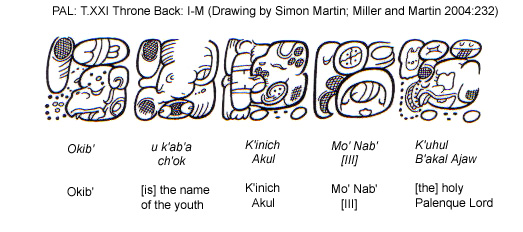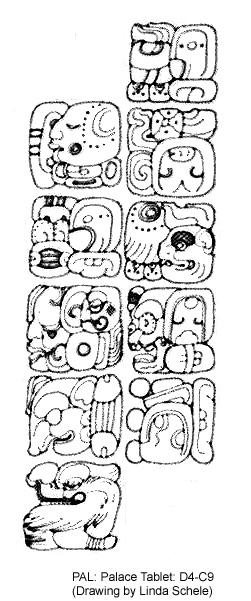
 |
WHO'S WHO IN THE CLASSIC MAYA WORLD Peter Mathews |
||||||||
|
Classic Maya Names: Child Names The names by which we know most Classic Maya kings appear to be names that were given to them upon their accession. However we also have occasional references to 'child names'. We have glimpses of this system from both birth and accession statements, as well as from occasional name captions. A clear example of a child name can be seen on the beautiful tablet or throne back recently found in Temple XXI at Palenque. This tablet was dedicated during the reign of K'inich Akul Mo' Nab' III of Palenque in AD 736. The scene on the tablet portrays the king in the court of his grandfather, the great king K'inich Janab' Pakal I, who is in the center of the scene, seated on a throne. The future king K'inich Akul Mo' Nab' III is seated below him, to the (viewer's) left of K'inich Janab' Pakal I. (K'inich Akul Mo' Nab' III's heir, U Pakal K'inich Janab' Pakal II-either his son or his younger brother-is also portrayed as an attendant.) As on many Maya tablets, the scene on the throne back from Temple XXI is an anachronistic one: K'inich Akul Mo' Nab' III had just turned five when K'inich Janab' Pakal I died, and the odds are that U Pakal K'inich Janab' Pakal II was not even born during his illustrious namesake's lifetime). In the scene, K'inich Janab' Pakal I seems to be holding out a stingray spine bloodletter to the prince who would later be known as K'inich Akul Mo' Nab' III, who turns away as if trying to avoid what Bowditch long ago called "a painful Maya ceremony". The point here is that the name caption of the young K'inich Akul Mo' Nab' III on the Temple XXI tablet is located above his portrait. The caption reads Okib' u k'ab'a ch'ok K'inich Akul Mo' Nab' K'uhul B'akal Ajaw, and the translation is as follows: 'Okib' is the name of the youth K'inich Akul Mo' Nab' III, the holy Palenque lord'. In other words, we are told quite explicitly that the 'child name' of K'inich Akul Mo' Nab' III was Okib'.
Child names of future kings are known from several other sites as well; notably, most are from sites in the western Maya lowlands, such as Palenque, Piedras Negras, and Yaxchilán. In some cases rulers continued to use their child names after they became king. For example, the Yaxchilán ruler Itzamnaj B'alam II very commonly uses the name Chelte' Chan K'inich. This was his birth name and was used almost universally in pre-accession references to him. Even after his accession, however, he referred to himself as Chelte' Chan K'inich more often than as Itzamnaj B'alam (IV). References
|
|||||||||
Previous Page | Introductory Page | Next Page | |||||||||
|
Text links to all pages at this site are available at the FAMSI INDEX |
|||||||||

